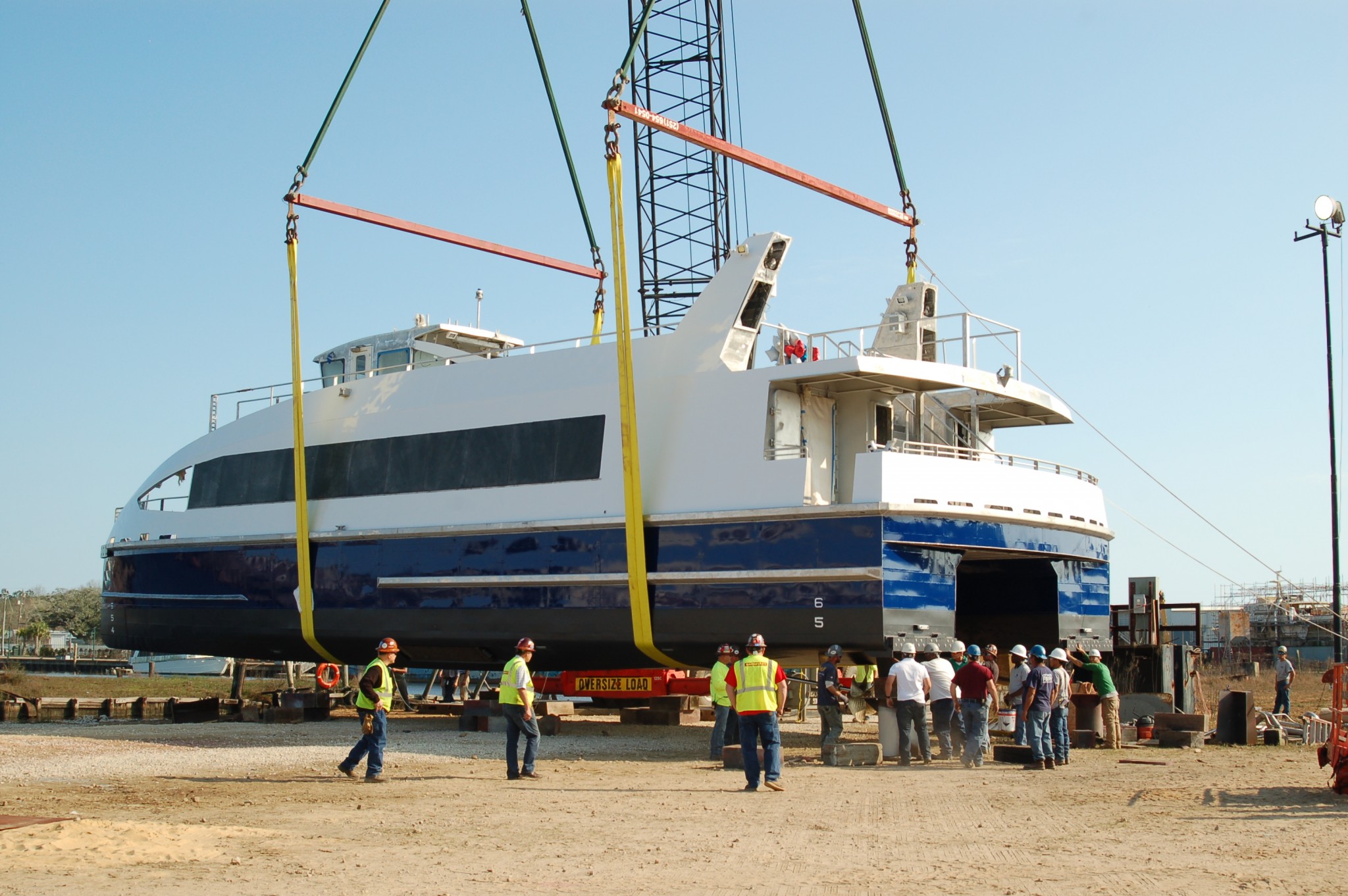The first 86'x29' aluminum high-speed catamaran ferry for New York’s Citywide Ferry entered the water yesterday at Horizon Shipyard in Bayou La Batre, Ala.
Horizon is building 13 of the 19 new 149-passenger ferries designed by Incat Crowther that will service six routes and 10 new ferry landings. (The other six sistership ferries are being built at Metal Shark in Franklin, La.) San Francisco-based Hornblower Cruises & Events subsidiary HNY Ferry Fleet will operate the new ferry service. Now that the boat is in the water, it still has to go through final outfitting, dock trials and sea trials in Alabama before it makes its debut in New York.
“We got the award in June (2016) and we started planning,” Lance Lemcool, Horizon’s business development manager, said as he watched the crew from Barnhart Crane & Rigging, Theodore, Ala., prep the first ferry for its move from a crawler to the water via crane. “We had our plan fleshed out in four weeks and we were cutting jigs.”

A crane operator and rigging crew move the ferry into position. Ken Hocke photo
The delivery schedule is tight, with 10 of the boats from Horizon scheduled to be in New York this summer. The other three will follow in 2018. The first boat is scheduled to leave the shipyard in March. “We try to keep the same teams of builders repeating the same processes for each of the boats,” said Lemcool. “The first one is the hardest. After this, things will start to move faster.”
In addition to carrying 149 passengers, the new ferries will be equipped with Wi-Fi, and feature concessions and space for bikes, strollers and wheelchairs. The vessels will be ADA and Local Law 68 (Accessible Water Borne Commuter Services Facilities) compliant and run on routes named Rockaway, Astoria, South Brooklyn, North Brooklyn, Lower East Side and Soundview. Not all the boats will be exactly the same, however. Three of the ferries being built at Horizon will have a deeper depth, draft and freeboard than the others. The Rockaway ferries will measure 86'x26'3"x11'6", with a draft of 4'2" and a freeboard of 7'4". The other boats, known as the River ferries, will measure 86'x26'3"x8'6", with a draft of 3'3" and a 5'10" freeboard. The Rockaway ferries are beefier because they could encounter rougher water at certain times of the year.
The rigging crew took extra time with the straps that ran under the boat’s hull to create a double sling. “We take a conservative approach with the rigging. We don’t hurry anything,” said Barnhart’s Scott McDonald.

The boat finally hit the water. Ken Hocke photo
Main propulsion for the new ferries will come from twin Baudouin 6M26.3, Tier 3 diesel engines producing 815 hp at 2,100 rpm each. (The Rockaway boats will carry Baudouin 12M26.3 diesels, producing 1,380 hp at 2,100 rpm each.) The mains will connect to 5-bladed, NiBrAl, 38" Michigan Wheel propellers through ZF 2050 marine gears with 2.519:1 reduction ratios. (The Rockaway wheels will measure 42".) The propulsion packages will give the River ferries a running speed of 25 knots and the Rockaway boats a running speed of 27 knots.
Jerry Stennis, a shipfitter on the project has worked with both aluminum and steel. “Aluminum takes a little more prep work, but that’s okay. It’s a beautiful boat,” he said. “It’s a great project for a lot of reasons, especially the fact that it gives us all a job.”
At Horizon, the boats are constructed in a modified assembly line fashion, moving in and out of three sheds until eventually they are launched. Lemcool said that the Incat Crowther design is great, but there were some challenges. For example, some of the brackets are different by the smallest of margins, and it was easy for shipyard workers to mix them up. So Bayou Metals in New Orleans, who does all the Horizon cuttings for this project, puts the brackets with the corresponding frames in a segmented box in the first shed. “The brackets are then connected to the frames where they belong,” said Lemcool. “As the frames are erected, the worker just pulls off the brackets and welds them in place. We want as much of the boat put together as we can before it moves to the main assembly shed.”
Capacities for the new River ferries will include 750 gals. of fuel and 200 gals. water. Tankage for the Rockaway ferries will be 1,000 gals. fuel and 200 gals. water.
John Lander, who runs Horizon’s west yard where the ferries are being built, eyed the operation like a father dropping off his child for the first day of kindergarten. “It’s been a challenge. Lots of late nights and long days,” he said. “We’re grateful to have the work, but you worry all the time.”
Finally, the crane’s engine revved, the straps went taught, and the new boat lifted off the crawler. A handful of riggers, using lines connected to the boat, turned the vessel, lining it up perpendicular to the dock. The crane operator, with riggers hanging on their ropes, moved the boat out over the water, placing it down like an egg in a basket — no splashdown.
C.J. Jordan, outfitting foreman, stared down at the new boat as it sat in the water, a small smile trying to escape from underneath his mustache. “We’re the last guys on the vessel. We take care of all the little things, check the doors, the hatches, look for leaks,” he said as he walked toward the boat for another inspection. “Time to go back to work.”
In two weeks, the process will be repeated and the beat will go on from there.




